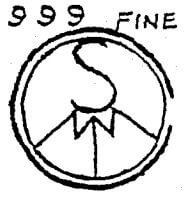Precipitates mixed with diatomaceous earth from the precipitation filter unit are dried in a filter press and mixed with borax and soda ash. This mixture is then melted in a diesel-fired furnace and cast in a silver dore cone. This cone is then melted in another furnace into an anode 7 inches by 9 inches by ½ inch thick for electrolytic refining.
The silver dore’ anode is refined to 999+ fine silver crystals using silver nitrate electrolyte and stainless steel cathodes in an electrolytic refining cell. The silver crystals are scraped off the cathodes, rinsed, dried, and melted again into 10 ounce bars or whatever size is on order. Each bar is stamped 999 fine and the S/MM logo added.

The gold is collected with the other impurities from the bottom of the cell and is chemically recovered by using a nitric acid bath to dissolve everything but the gold. This small amount of gold is collected and when enough has been processed, it is melted into 1.5 ounce bars.
Precipitates from the Merrill-Crowe precipitation filters average about 50 percent silver. Most of the remainder is diatomaceous earth (silica) used in the filter media.
Use a flux mix of 30 percent borax and 3 percent soda ash (dry weight) when smelting the precipitates. The raw silver anodes measure 7 inches by 9 inches by ½ inch.
Power requirements for the refining cell are 1.8 to 4 volts and 10 amperes D.C. per anode in cell. Power varies with the number of anodes in the cell. Capacity, 6 anodes.
